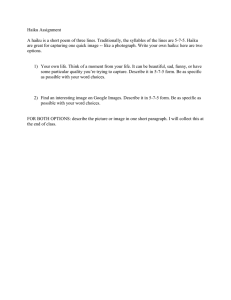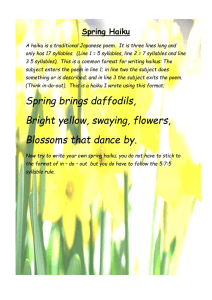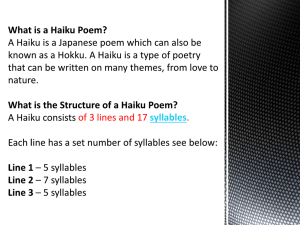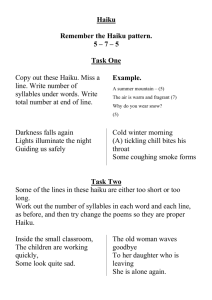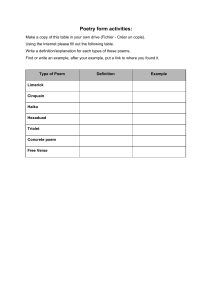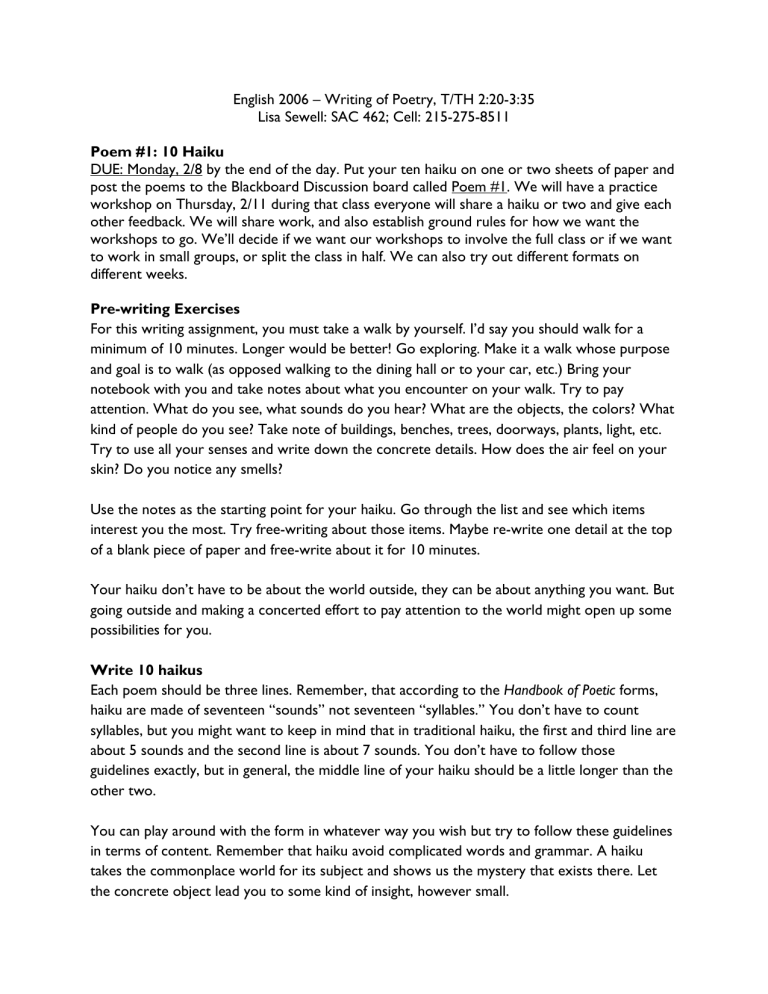
English 2006 – Writing of Poetry, T/TH 2:20-3:35 Lisa Sewell: SAC 462; Cell: 215-275-8511 Poem #1: 10 Haiku DUE: Monday, 2/8 by the end of the day. Put your ten haiku on one or two sheets of paper and post the poems to the Blackboard Discussion board called Poem #1. We will have a practice workshop on Thursday, 2/11 during that class everyone will share a haiku or two and give each other feedback. We will share work, and also establish ground rules for how we want the workshops to go. We’ll decide if we want our workshops to involve the full class or if we want to work in small groups, or split the class in half. We can also try out different formats on different weeks. Pre-writing Exercises For this writing assignment, you must take a walk by yourself. I’d say you should walk for a minimum of 10 minutes. Longer would be better! Go exploring. Make it a walk whose purpose and goal is to walk (as opposed walking to the dining hall or to your car, etc.) Bring your notebook with you and take notes about what you encounter on your walk. Try to pay attention. What do you see, what sounds do you hear? What are the objects, the colors? What kind of people do you see? Take note of buildings, benches, trees, doorways, plants, light, etc. Try to use all your senses and write down the concrete details. How does the air feel on your skin? Do you notice any smells? Use the notes as the starting point for your haiku. Go through the list and see which items interest you the most. Try free-writing about those items. Maybe re-write one detail at the top of a blank piece of paper and free-write about it for 10 minutes. Your haiku don’t have to be about the world outside, they can be about anything you want. But going outside and making a concerted effort to pay attention to the world might open up some possibilities for you. Write 10 haikus Each poem should be three lines. Remember, that according to the Handbook of Poetic forms, haiku are made of seventeen “sounds” not seventeen “syllables.” You don’t have to count syllables, but you might want to keep in mind that in traditional haiku, the first and third line are about 5 sounds and the second line is about 7 sounds. You don’t have to follow those guidelines exactly, but in general, the middle line of your haiku should be a little longer than the other two. You can play around with the form in whatever way you wish but try to follow these guidelines in terms of content. Remember that haiku avoid complicated words and grammar. A haiku takes the commonplace world for its subject and shows us the mystery that exists there. Let the concrete object lead you to some kind of insight, however small. • • • Line #1 must have a location or some kind of concrete object, detail or image– a time of day, a place, a room, a piece of furniture, something in nature (like a mountain, a tree, a beetle, a leaf), something in the outside world that isn’t part of nature (like a street sign Line #2 must contain a reflection or an abstract concept or idea Line #3 should try to connect the first two lines or perhaps go off in some completely unexpected direction. Think of Line #3 as your wild card. Write whatever comes into your head! You could also reverse the order of Line #2 and Line #3 so that the concept or larger idea comes in the final line. Don’t worry about logic or making sense. You can see from the examples we looked at that haiku often follow a logic of juxtaposition – of putting one thing next to another thing and thinking about how they resonate together. Take a look at the haiku you liked from the reading assignment and try to figure out why you like it. Take your inspiration from the haiku that you find interesting. You are also welcome to write 10 haiku about as single subject, as Sonia Sanchez does in her poem about Emmet Till. Just make sure that your poems include images.
